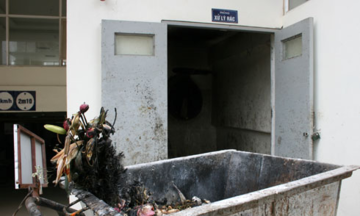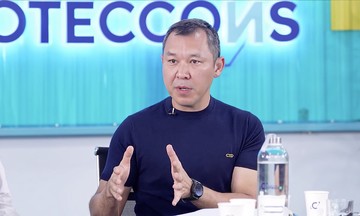Holding large amounts of cash, insurance companies often seek ways to generate profits from this capital through financial investments. Typically, they choose low-risk channels with moderate returns such as bank savings deposits, certificates of deposit, or bonds. However, portfolio managers may also allocate a certain percentage to pursue higher returns through stock investments.
According to the consolidated financial report for Quarter II, Bao Viet Group (BVH) currently holds nearly 3,670 billion dong in trading securities, of which over 3,279 billion is in listed stocks. Their portfolio includes shares of ACB, CTG (Vietinbank), VNM (Vinamilk), and several others.
Overall, Bao Viet's listed stock portfolio is experiencing losses, as the book value at the end of June was only nearly 3,121 billion dong, requiring provisions of nearly 159 billion dong. The investment with the largest deficit is VNM, requiring provisions of nearly 123 billion dong, equivalent to 29% of the original cost.
According to accounting regulations, companies must set aside provisions for price reductions to ensure that investments are not recorded higher than their realizable value. This practice accurately reflects asset values on financial statements and creates a financial source to offset potential losses.
In addition, Bao Viet has allocated nearly 63 billion dong to invest in unlisted shares of companies such as Ca Mau Seafood (CAT), Phuong Dong Shipping and Trading (NOS), Vietnam Engine and Agricultural Machinery Corporation (VEAM), and MBLand. The book value at the end of June was nearly 40 billion dong, indicating a loss provision of over 36%.
BVH's securities portfolio also includes fund certificates with a total value of over 297 billion dong. These are the only investments not requiring loss provisions. They are investing in three "in-house" funds: BVPF, BVBF, and BVFED of Bao Viet Fund, in addition to the DCVFMVN30 ETF fund of Dragon Capital.
With a lower stock investment of approximately 284 billion dong, Bao Minh Insurance Corporation (BMI) has a highly diversified portfolio. They invest in 33 stocks, including those listed on HoSE, HNX, UPCoM, and unlisted stocks. The company has set aside over 58 billion dong for price reduction provisions, equivalent to over 20% of the portfolio.
Out of the 33 stocks in which BMI is currently investing, only five do not require loss provisions: TCB, CTG, MBB, VPB, and the unlisted stock of Dia oc 9. The remaining investments all require provisions.
Bao Minh's two most significant investment losses in the past six months are NOS (Phuong Dong Shipping and Trading) and DGT (Dong Nai Transport Construction), with provision levels of 92.5% and 87.4%, respectively. Both are listed on UPCoM. Additionally, all UPCoM-listed stocks in which BMI has invested, such as GDA, DVN, CLX, VEA, ACV, and ABB, currently require provisions.
Besides the two aforementioned major players, several other insurance companies also allocate a portion of their portfolios to stock investments. Bao Long Insurance (BLI) has over 19 billion dong in trading securities. Of this, almost 4.2 billion dong was invested in TCB (Techcombank), and the current fair value is only over 783 million dong, requiring a loss provision of nearly 3.4 billion dong. However, Bao Long also invested 15 billion dong in Dragon Capital's DCDS fund certificates, with a current fair value of nearly 17.5 billion dong. Thanks to this, the loss on BLI's total portfolio is only about 6%.
Petrolimex Insurance (PJICO - PGI) has over 22 billion dong invested in four stocks: HPG (Hoa Phat Group), SKV (Khanh Hoa Salanganes Nest), PLA (PLand), and DPM (Phu My Fertilizer). PLA is the only investment requiring a loss provision of nearly 3 billion dong, equivalent to almost 60% of the original cost. The remaining investments in HPG, KSV, and DPM are currently profitable, with gains of 72%, 31%, and 7%, respectively, in the first six months of the year.
 |
Investors monitor the stock ticker during a market downturn. Photo: An Khuong
The stock portfolios of insurance companies are at risk of loss while the VN-Index increased by 8.6% in the first half of the year, reaching its highest level since 4/2022. During that time, the market experienced a sharp and sudden correction in early April due to the announcement of countervailing duties. This decline caused the general index to drop 17%, falling below 1,100 points, and forcing many securities companies to lower their growth forecasts. The market subsequently recovered strongly thanks to government actions to mitigate the impact of the tariffs.
However, the recovery in the first half of the year was uneven, mainly led by banking stocks and Vingroup-related stocks. This is also clearly reflected in the stock portfolios of the aforementioned insurance companies. Most investments not requiring loss provisions are in bank stocks. Conversely, companies that have not yet found attractive market narratives or are in groups affected by tariffs, at least psychologically, have not yet caught up with the recovery wave.
Bao Minh invests in eight stocks on UPCoM, a market known for high volatility, offering significant potential returns but also considerable risks. The two stocks currently provisioned at around 90% of their value, NOS and DGT, are small-cap stocks with very low liquidity. NOS has been restricted from trading by the Hanoi Stock Exchange (HNX), with a market price of less than 1,000 dong per share. DGT continues to trade normally, but its market price has not recovered after three consecutive quarters of losses.
Speaking with VnExpress, Mr. Hans Nguyen, Director of EXM Wealth Management, a provider of asset management solutions for high-net-worth individuals, explained that insurance companies offer various products. Some are purely insurance products, while others are designed for investment. If a company offers investment-related products, they will participate in the market similarly to an investment fund. Therefore, engaging in financial investments or buying stocks is a normal activity for insurance companies, within their product strategy.
When insurance companies receive customer funds based on a contract with an investment component, they must assess the market and control risks. Similar to the work of a fund management company, insurance companies will rely on investment criteria and strategies to establish clear risk control frameworks and mechanisms.
In reality, stock investments by insurance companies represent a very small proportion of their total assets. This ratio is about 1.2% for Bao Viet and 3.8% for Bao Minh. Therefore, even with losses, stock investments are unlikely to significantly impact their business performance or financial health.
Tat Dat












